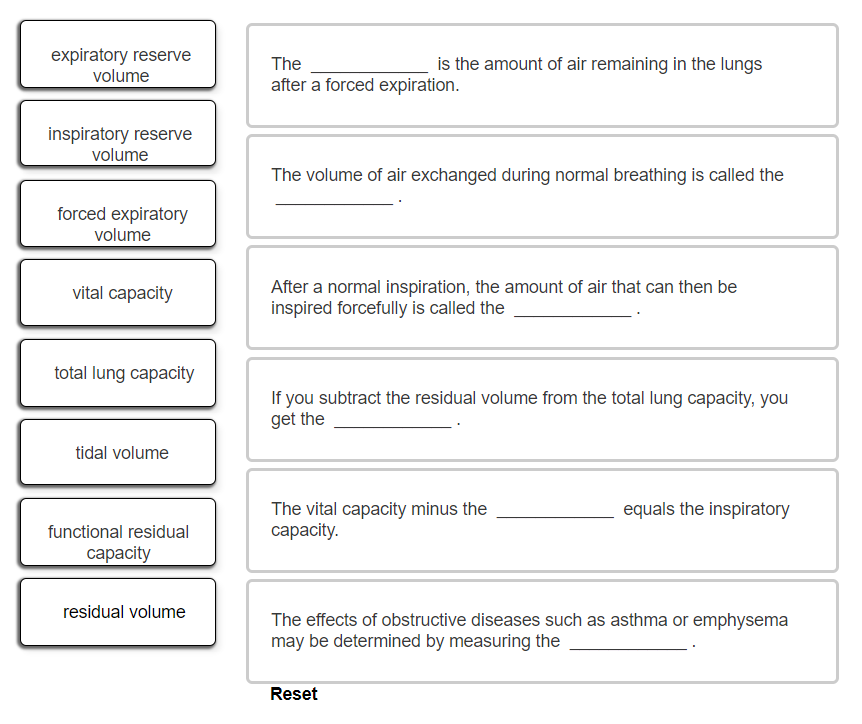The Amount Of Air Remaining In The Lungs After A Normal Breath
TLC is the total volume of the lungs at maximal inspiration which is about 6 L on average though true values are dependent on the same factors that affect residual volume. Tidal volume is the volume of air inhaled in a single normal breath.

Solved Expiratory Reserve Volume The After A Forced Expir Chegg Com
Likewise the amount of air normally breathed outward exhaled represents just a portion of the total amount of air that can be expelled.

The amount of air remaining in the lungs after a normal breath
. The FRC also represents the point of the breathing cycle where the lung tissue elastic recoil and chest. On average this volume is around one-half liter which is a little less than the capacity of a 20-ounce drink bottle. 31-Residual volume RV Air left in the lungs after a forced exhalation.Minute volume generally decreases when at rest and increases with exercise. This is the amount of air remaining in the lungs after normal expiration. The tidal volume minus the dead space.
Amount of air inhaled during a normal breath. In a normal individual this is about 3L. The amount of air left in the lung after normal expiration c.
The volume of air that remains in the lungs after a. Click here to get an answer to your question The amount of air that remains in the lungs after a normal exhalation is the _____. Inspiratory capacity is the volume of air that can be inspired following a normal quiet expiration.
The expiratory reserve volume ERV is the additional amount of air that can be exhaled after a normal exhalation. The total lung capacity of the adult male is six liters. A normal minute volume while resting is about 58 liters per minute in humans.
Functional residual capacity FRCis the volume remaining in the lungs after a normal passive exhalation. Functional residual capacity FRC. 12-Inspiratory reserve volume IRV Amount of air that can be further inhaled after a normal inhalation.
05-Expiratory reserve volume ERV Amount of air that can be exhaled after a normal exhalation. In a normal individual this is about 3L. The amount of air left in the lung after maximal expiration d.
The volume of the lungs decreases with inspiration. Functional residual capacity is the volume of air remaining in the lungs after this normal quiet expiration and is equal to expiratory reserve volume residual volume. Air moves into the lungs because A.
The FRC also represents the point of the breathing cycle where the lung tissue elastic recoil and chest. During normal breathing about 12 of the air in the lungs is replaced after one breath. The thorax is muscular.
For example during light activities minute volume may be around 12 litres. FRC is the amount of air remaining in the lungs after a normal physiologic expiration Figure 1A. The functional residual capacity FRC represents the volume of air remaining in the lungs after expiration of a normal breath ERV RV.
The total lung capacity TLC about 6 L is the maximum amount of air that can fill the lungs IRV TV ERV. The amount of air moved in or out of the lung with each breath b. Riding a bicycle increases minute ventilation by a factor of 2 to 4 depending on the level of exercise involved.
This means that exchange of gases is not interrupted between breath. It is equal to ERV RV 11001200 2300mlue the pr ocess of respiration. The residual volume represents the volume of air that remains in the lungs even after a forceful expiration.
Write an exponential decay model for the amount of the original air left in the lungs if the initial amount of air in the lungs is 500 mL. Tidal volume TV measures the amount of air that is inspired and expired during a normal breath. The air taken in with a normal breath represents only part of the total amount of air the lungs can hold.
Functional residual capacity FRC is the volume remaining in the lungs after a normal passive exhalation. All of the answers are correct. Inspiratory capacity is the amount of air taken in during a deep breath and residual volume is the amount of air left in the lungs after forceful respiration.
The gas pressure in the lungs is less than outside pressure. The vital capacity VC is the maximum volume exhaled after maximum inhalation IRV TV ERV. The maximum amount of air that can be blown out of the lungs after taking a deep breath is known as.
The average value of residual volume varies between 1000 ml to 1100 ml. The functional residual volume also prevents collapse of the alveoli on expiration. Contraction of the diaphragm decreases the volume of the pleural cavity.

Lung Volumes And Capacities Flashcards Quizlet

Pin By Ipek Olsun On Biyoloji Respiratory System Anatomy Respiratory Therapy Respiratory System

Pin Op R E S P I R A T O R Y I N F O

Tidal Volume Tv Amount Of Air Inhaled And Exhales In One Cycle During Quiet Breathing Ins Respiratory Care Respiratory Therapy Respiratory Therapist Student

Person Floating In Air Png Business Card Mock Up Person Silhouette Floating

The Volume Of Air That Will Remain In The Lungs After A Normal Expiration Is Called


Posting Komentar untuk "The Amount Of Air Remaining In The Lungs After A Normal Breath"